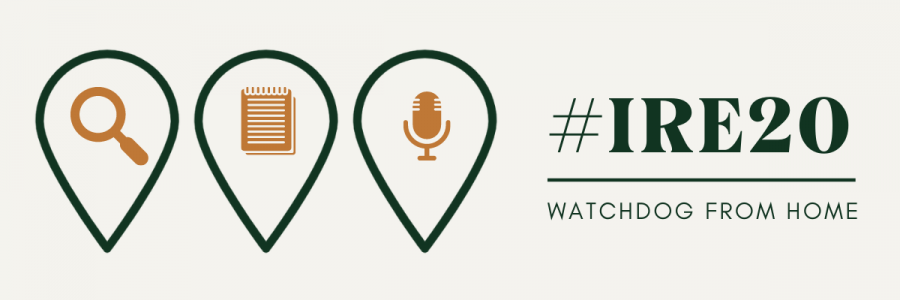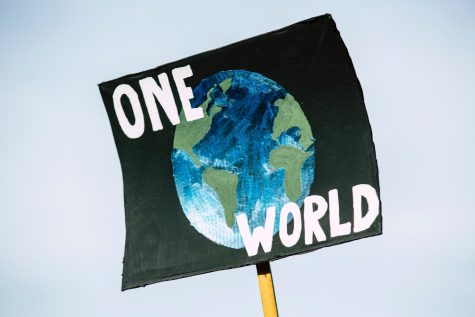#IRE20: Tips, panels, Q&A’s
September 22, 2020
The articles below include summaries and quotes from panels and conversations from the virtual 2020 IRE Conference. All points mentioned below, even if not explicitly mentioned in the line, are credited to the event speakers and IRE.
THUR/FRI: Marginalized communities in journalism
PANELS: How to collaborate with underrepresented communities in your journalism AND Tapping the power of ethnic media in America’s coverage of racial equity
“The goal is to include [underrepresented groups] in ways that are empowering and collaborative rather than exploitative and exclusionary.” – Anita Li, Board Member at Online News Association
Tips when reporting about vulnerable populations (Mauricio Peña, Block Club Chicago)
- Explain
o “A big mistake of any journalist is to assume that everyone understands how journalism works. In my experience, I’m often the first reporter that some folks are interacting with.”
o “For me, I always explain what it means to have their name in print, explain the risks, explain the benefits. Afterwards, I let them decide whether they want to share their story with me.”
o “If they say yes, I ask them whether they want to use their full name, just their first name or an alias. I want to be very respectful of the different circumstances that people are in.”
- Safe Interview Space
o “I think we understand how vulnerable it is to share your personal story as journalists and I think we need to provide that safe space where people will open up.”
- Check Before Publishing
o “I just check in with them to see if they’re still comfortable with me using their name, if I’m using their name, and I just want to make sure they’re still okay with it, if they have any other questions for me, if there’s anything else they want to add to the story.”
- Share the Story with Them
o “I think it’s critical to let them how it came out and also for it be in the language that they speak if they’re not native English speakers.”
The following are select quotes from the panel, “Tapping the power of ethnic media in America’s coverage of racial equity.” The panelists are members of “ethnic” media organizations and spoke to their experience working in the field and the brand of “ethnic media.”
“The lens of ethnic media, in fact, is not only about its own community, about its own city, or region. In fact, its lens is global.” – Odette Alcazaren-Keeley, Maynard Institute for Journalism Education
“Everybody should be able to go into the community. If you go into any area, and this is where journalism has to do a better job, because you have to get out and walk and put your feet to the ground and get in the communities and learn.” – Cheryl Smith, Texas Metro News
“When you think about ethnic media, this is a sector where fake news actually doesn’t even exist, because there’s such an innate trust. Of course, it’s not completely a blanket and universal, but there’s just the core of, we know that these are people who are covering our stories.” – Odette Alcazaren-Keeley, Maynard Institute for Journalism Education
“We’re the only one’s allowed into those situations, into homes, because we have spent so much time not only gaining trust but just really integrating ourselves into the community and really showing that these are matters that are effecting us and we’re really trying to accurately and patiently tell that story. At the end of it, we’re not just ethnic media, we’re media. We’re covering what’s going on.” – Khanstoshea Zingapan, Black Zebra
“I am always amazed at how much readers and audience thank us for what we do. They’ll call up out of the blue and just thank you for being there. And it’s very different than, I remember, when I was in mainstream media, there were calls that I’d get where I’d have to hold the phone at the other end of the room because they were yelling so loud. Folks are just really, genuinely touched.” – Mark Trahant, Indian Country Today
WED: Immigration crisis on the border
PANEL: Investigating the immigration crisis on the border
The following tips were presented by Oriana Zill de Granados, Producer at CBS News 60 Minutes. Select points have been included below.
1. Don’t forget about a source after a story
“Call them, not for a story, but just to say hi. I regularly have a list of 10 or 12, sometimes a 100 people that I call and keep in touch with them. Maintaining that source development and really calling them when you don’t need something from them to check-in or to meet with them and have lunch if you can is critical.”
2. Keep sources informed
“If a source does not like the story, the best thing to do is to warn them that it is coming. Be straight with them and direct. Before a story airs on 60 minutes, I make about 30-40 phone calls to every single person who helped me on the story and I let them know it is coming and I let them know whether it is going to be positive or negative to them and I tell them why and the basic gist of it. Because people don’t get as upset when you are straight with them and when they know something is coming. So if it is a negative story on someone and they know, they are going to be able to prepare emotionally or whatever else they need to do, legally. So I, in general, find that being straight with people and direct, you get a lot more respect from them over time even when you are doing a negative story that they don’t like.
3. Always corroborate information from sources
“My take on this is that in general, you need to make attempts to corroborate everything that they are telling you. I think Valeria’s [Fernandez, independent journalist] tactic of getting them to sign something is really useful because it forces them to be more honest. They know you can check upon them. That is a way of ensuring, even if you can’t eventually get all the information from ICE, it is a way of ensuring they know you can try. It is important to do everything you can and if you can’t, it is important, to be honest with your audience about what you couldn’t find.”
TUE/WED: The importance and mechanics of allyship
PANELS: Conversation: Being a better ally AND Do you qualify as an ally?
“The key to allyship is empathy, is listening, sort of getting out of our own head and being more curious.” – Robert Raben, president and founder of The Raben Group.
The following points were presented by Moiz Syed during the “Conversation: Being a better ally” panel, from his presentation. Select points have been included below. While the panel focused on journalists of color, the following points are applicable to allyship in general.
Four levels (and sub-levels) to being a white ally:
- Work on yourself
a. Expand your personal social circles.
b. Learn how to pronounce our names.
c. Read, listen, share, experience the works of people of color.
d. Don’t be defensive.
- Listen and share information
a. Acknowledge people of color and their experiences.
b. Information is power. Be transparent with people of color.
- Support the word and voices of people of color
a. Express solidarity in public and not just in private.
b. Give credit, especially when you see a POC’s work being erased or ignored.
- Take direct action
a. Speak up in white spaces where people of color can’t be heard.
b. Volunteer to do the less glamorous diversity work.
c. Implement the necessary change. Don’t just wait for people of color to do all the work.
“An ally is to be a trusted force for good. Trust is confidence in the face of risk that the other person will do the right thing. You’re not an ally unless others believe you qualify. You can’t just claim it.” – Jill Geisler, Loyola Chicago/Freedom Forum.
The following points were presented by Jill Geisler during the “Do you qualify as an ally?” panel, and from her notes. Select points have been included below. While the panel focused on inequality in the workplace, the following points are applicable to allyship in general.
10 (of many ways) to qualify as an ally:
- Understand that power affects our perspectives.
Ex: Managers overestimate workplace morale, engagement and opportunities.
- Recognize the realities and risks of unconscious bias.
Why do you or I think/say/believe that? How can you or I confirm that? Alert others to the influence and impact of unconscious bias.
- Be a learner – but don’t presume anyone is obligated to be your teacher.
Educate yourself about current and historic patterns of bias, harassment and discrimination. Don’t expect that others owe you guidance or coaching; respect the labor – especially the emotional labor involved. Don’t presume that one person speaks for the entirety of any race, ethnicity or gender.
- Recognize the “invisible work” done by underrepresented employees.
Ex: Underrepresented employees are expected to coach, counsel, translate and represent.
- Understand the meaning and impact of microaggressions.
Ex: Presuming to know the skills, interests or roles of others/ Citing personal connections to prove your lack of bias.
Check your own behaviors. Be a learner and a teacher; explain the impact of aggressions to those who don’t yet understand.
- Find your voice for courageous conversations.
Speak proactively by initiating the conversation. Speak reactively by responding to words and actions.
- Challenge systems, practices and assumptions that foster inequity.
Ex: If your team is diverse, do the traditionally underrepresented employees feel they actually have a voice in decision-making?
- Measure what matters.
Use metrics to support ideas and initiatives. Collect data for diversity in staffing, recruiting, retention and wage parity. Supporting data can help you respond to misinformation and myths.
- Be more than a mentor; be a sponsor.
A mentor gives advice. Mentorship requires time and attention. A sponsor advocates. Sponsorship requires time, attention, assessment, coaching and a willingness to put your reputation on the line to help advance another.
- Be more than an ally.
a. Amplifier: I echo your ideas and make certain you get credit.
b. Accomplice: I’m in on the planning, in a role you welcome.
c. Advocate: I listen, learn and take a stand.
d. Active Bystander: I intervene.
e. Ally to the Allies: I support others who step up.
MON: Ted Oberg’s 10 most important lessons
PANEL: 10 most important lessons I’ve learned
Three TV news veterans shared the 10 most important lessons they have learned in their careers.
Ted Oberg, an investigative reporter for KTRK in Houston:
1. Never stop searching
Whether it is for a specific story or just for simple curiosity, Oberg recommends keeping information flowing. Further down the line, information like this might turn into potential stories.
“It sounds like a pretty broad, a fortune cookie kind of thing, but to me what that means is I send an FOIA request every week whether or not I need that information.”
2. Avoid Zoom whenever possible
“I think Zoom is going to be with us for a while but it is very hard to hold people accountable, to ask the follow-up questions that we need to do, and to get emotion from victims.”
It is possible to report safely using social distancing and masks.
3. Avoid the visual cliches
Translating the numbers into appealing visuals is done so that the reader is not overwhelmed. However, there are certain journalistic cliches that need to be avoided.
“If as a group, and IRE may be a voting block, can we avoid the paper thumb?”
4. Send handwritten thank you notes to sources
Oberg says he sends a handwritten thank-you note each time he interviews a new source. This, Oberg says, guarantees that the source will not ever ignore a call from him.
5. Show viewers how you got your information
Also known as “process reporting,” showing viewers how you got your information helps to establish trust.
“Sometimes, it is as simple as saying, ‘I called this person six times, starting on this day and ending on this day. Sometimes, it is showing how you got the documents.”
6. Don’t wait for a home run, because singles score runs too
“The point is, don’t necessarily wait to have a story tied up. Don’t wait for everything to have a conclusion, to get results before a story is ready to air. As I said, we’re a quick turn, high volume unit. We believe that being on the air with a lot of follow-ups is a great way to reinforce the fact that we continue to investigate stories and, to use the football analogy, to continue to push the ball downfield.”
7. Our work is serious, but you don’t always have to be
“Let viewers know that this is a fun job. Everything we do doesn’t have to be the cliched investigative reporter with a furrowed brow and a document in their hand. Sometimes you can have a little fun.”
8. Always grow your audience
“We have built our audience online by building out our stories online, our investigations online to include great interactives.”
9. Fair TV is better TV
“Always send every document you intend to ask someone about in an interview to that person. I would say, even if they haven’t agreed to the interview yet. I know this goes against what some of your core values are, that you love that moment that you are able to pull something out and ask someone, ‘what about this?’ It is an OK television moment. But in my mind, it doesn’t necessarily present a fair picture to the audience, nor to the person you are interviewing. I believe we are playing a long game with both the audience and our source and we owe them, “Look, here is what we are gonna ask you about. Get prepared. So that when I ask you this, ‘I don’t know’ is an unacceptable answer. We believe that is a core value, even in accountability and ambush interviews.”
10. Indulge your curiosity
Questions. Questions. Questions.
“The beauty of our jobs these days is that we are the few people in the newsroom who can sit and think for a minute and say, ‘I wonder if.’”
MON: Inequality reporting for any story
PANEL: Investigating inequality on any beat
The panelists discussed how inequality reporting shouldn’t be limited to the “race” beat, and how to identify aspects of inequality in any story.
What is inequality?
Melanie Hicken, senior investigative writer at CNN:
“I feel like I see inequality in a lot of different ways. Racial inequality, socioeconomic inequality, gender inequality. I think it really comes down to the dynamics of power – who has the power in the room, and who doesn’t have access to power in the same way because of some sort of attribute, whether its race, or gender, or sexual orientation.”
Alexia Fernández Campbell, senior reporter at the Center for Public Integrity, covering the labor beat:
“Who has power and who doesn’t. The relationship, the dynamic between employer and employee. The employer has the power; the employee generally doesn’t. That can lead to income inequality; that can lead to discrimination at work.”
Bracey Harris, staff writer at The Hechinger Report, covering the education beat:
“I start from a simple premise of who’s not in the room. There’s a gifted class, or there’s honors classes [in a school], and you don’t see students of color – that’s kind of that, ‘Who’s missing from the room?’ question. But on the other hand, if you’re going by the in-school suspension classroom and you see that it’s heavily concentrated with kids of color, that’s kind of raising those questions. Who’s not in the room, and who are the stakes the highest for – who’s being left behind?”
Kat Stafford, national race and ethnicity writer at The Associated Press:
“I always tell folks that race reporting and equity coverage should not just solely be within those specialty beats, right? We should all be finding ways to incorporate this sort of coverage into our own beats, whether that’s business, politics, or you name it.”
Identifying inequality in any story
- Look into pre-existing laws that are relevant to the story. Examples may include anti-discrimination laws and anti-wage theft laws. Find out what agencies are responsible for enforcing those laws and find out what complaints have already been filed. Discovering what laws govern the story, and if they are being properly enforced, can expose inequalities.
- Who are the vulnerable populations involved in the story? Children, elderly people, immigrants, low-income populations and racial minorities are important groups to look for. Most stories already have an inequality angle within them – it’s not necessary to actively pursue an “inequality story.”










